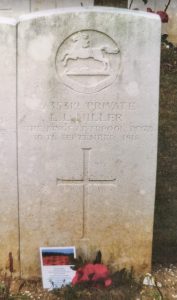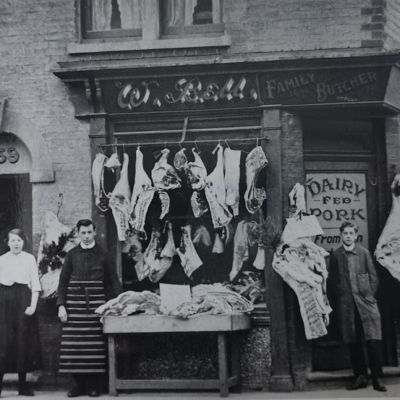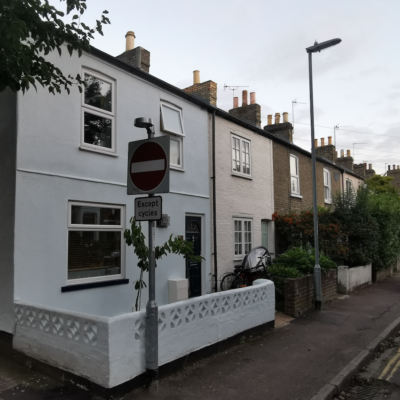Search by topic
- archaeology
- Building of Local Interest
- charity
- church
- crime
- dressmaker
- fire
- Great Eastern Railway
- Listed building
- Mapping Relief
- medieval
- oral history
- poverty
- Public House
- Rattee & Kett
- Religious House
- Roman
- scholar
- school
- Then and Now
- tudor
- women
- work
- world war one
- world war two
Search by text
 Leonard L Miller, Kate Emily and Reginald Leonard, 1917
Leonard L Miller, Kate Emily and Reginald Leonard, 191715 Ross Street
History of 15 Ross Street
1911
Ferdinand Oscar Riche, 63, retired railway clerk, b Westminster
Caroline Louisa, 33, housekeeper, b Cambridge
Charlotte Mary, 26, upholsterer, b Cambridge
Thomas, 23, cabinetmaker, b Cambridge
1913
Ferdinand Oscar Riche, retired clerk
1914
Leonard Lantaff Miller married Kate Emily Harding of 36 Bateman Street.
1916
In 2021 SMS wrote:
My father, Reginald Leonard Miller was born 4th August 1916 at 15 Ross Street. My grandfather Leonard Lantaff Miller was 26 years old in 1914 and shortly after the beginning of World War I, he decided to sign up to fight for his country at a rally in Cambridge. Initially he was with the Yorkshire Regiment, but at some point he joined the King’s Liverpool Regiment, 20th Battalion, the 19th Battalion and the 13th Battalion, as a Private. He was sent out to France, probably in 1917, since I have a photograph of my grandmother, my grandfather and my father then aged about 9 months – 12 months, which was probably an ’embarkation photograph’. Sadly, towards the end of World War I, in September 1918, Leonard was seriously injured, and was then taken to an Australian Tented Hospital in Abbeville on the mouth of the River Somme to be treated, but he died on 30th September, 1918. He is buried in Abbeville Communal Cemetery Extension, a very beautiful cemetery, which I visited in October 2009. I think that I have been the only family member to get to visit his grave. He was fighting in the Battle of the Canal du Nord and this particular battle commenced on 27th September 1918, so it is likely he was wounded either on 27th or 28th September, since he was transported to Abbeville to be treated, and where he died on 30th September 1918. The Miller family had already suffered one tragedy during World War I when Stanley Bertram Miller, Leonard’s younger brother, born 17th June 1890, a Lance Sergeant with the Cambridgeshire Regiment was killed on 31st July 1917 in the Third Battle of Ypres at Passchendaele. His body was never found, and his name is shown on Panel 50 of the Menin Gate Memorial in Ypres. We went to the 8pm Service which happens every night, and it was very sad, but so special as the people of Ypres carry out these tributes every night at the Menin Gate after the end of WWI.
Leonard and Stanley are also remembered on the memorial in Ely Cathedral, dedicated to the men of Cambridge who tragically died in World War I.
After her husband’s death, Kate Emily Miller [née Harding] was devastated by his loss and that her son, just a 2 year old child, had lost his father. The family rallied round, and between them, they helped her to carry on, and frequently had my father to stay with the different family members. At some point, Kate met Alfred Langford Sennitt, born 25th December 1873 in Stretham, Cambridgeshire, and they married on 14th May 1923 in the Parish Church, Brighton. Kate was 34 and Alfred was 49. He was a bachelor, and was the son of the late George Henry Sennitt, born 1841 died 1893, and Sarah Sennitt, nee Langford born 1841. George had been a Master Butcher and many of the Stretham Sennitt family were either farmers, poulters or butchers. Sarah Sennitt, together with Alfred had a slaughterhouse in Covent Garden just off the Mill Road, and also a butcher’s shop nearby.
Leonard had been brought up at 108 Gwydir Street but his family moved to Romsey Street and by 1911 he was living at no.19 Romsey Street.
By 1935, the Alfred Sennitt and Kate, had moved to 58 St Barnabas Road.
1962
Mrs Rodell
Contribute
Do you have any information about the people or places in this article? If so, then please let us know using the Contact page or by emailing capturingcambridge@
License
This work is licensed under CC BY-NC-SA 4.0










